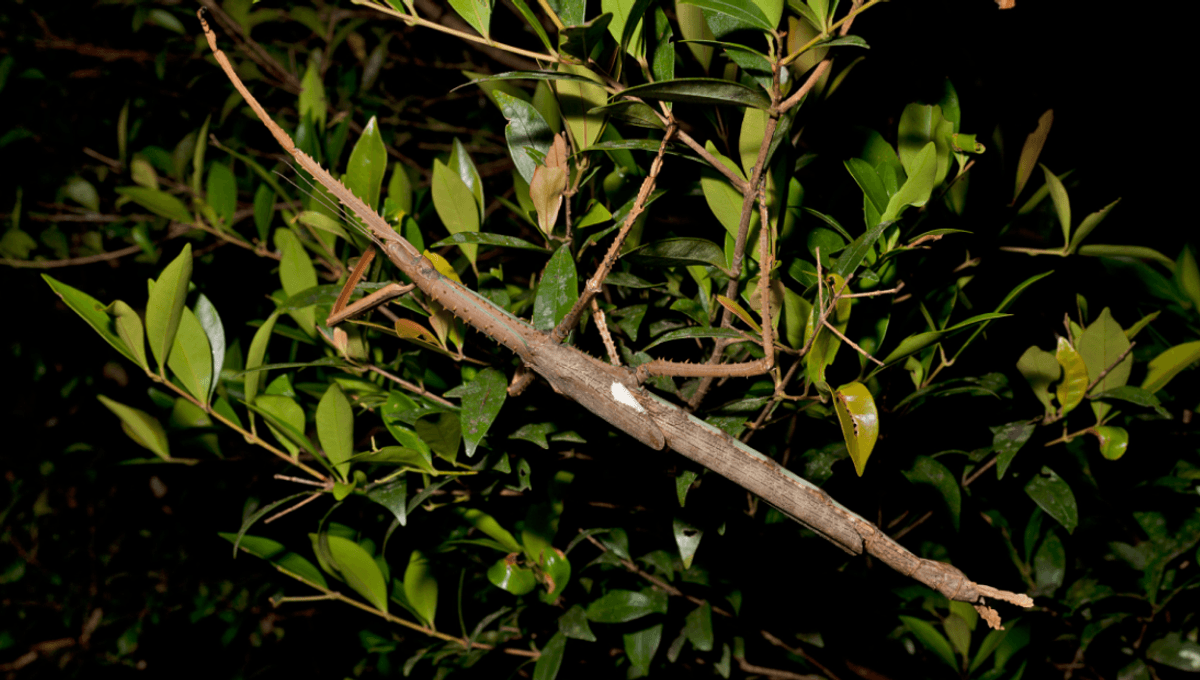
A new species of stick insect has been discovered in Australia, and it’s an absolute whopper. Named Acrophylla alta, it’s thought to be the heaviest known insect in Australia at 44 grams (0.09 pounds). That’s about the same as an egg.
If confirmed, it’ll knock the giant burrowing cockroach, Macropanesthia rhinoceros, off the top spot. To put its weight into context in the world of stick insects, a female Goliath stick insect weighs just 21 grams (0.04 pounds) even when laden with eggs, so A. alta really is an absolute unit.
It was discovered by a team of wildlife experts searching the wet tropics region of North Queensland, an area that encompasses many different habitat types scattered at drastically different altitudes. Tough work for human legs, but the environmental range has fostered the highest diversity of phasmid insects to be found in Australia (which is basically all your critters that look a bit like leaves or sticks).
Finding these animals isn’t easy, given they’re the masters of camouflage, and some of them live way up in the canopy, but when the weather gets rough, they can be knocked off their perch and brought down to our level. This means if you’re in the right place at the right time, you just might get to see something that nobody else has before, and this is where citizen science sites like iNaturalist get really exciting.
Pictures tipped off study author Ross Coupland that there might be something enormous lurking in the trees. As well as scanning the site for more photos of “phasmida” in Australia, Coupland went out with Prof Angus Emmott to search for phasmids at high altitudes of the Atherton Tablelands in North Queensland. That’s where they landed a whopper.
Between Millaa Millaa and Mount Hypipamee, they saw something huge up in the trees, so they used a long stick to get it down. They then took it home to study and measure it, and saw that, like all stick insects, it had very unique eggs.
“Every species of stick insect has their own distinct egg style,” said Emmott in a statement. “They’ve all got different surfaces and different textures and pitting, and they can be different shapes. Even the caps on them are all very unique.”
The new-to-science species was around 40 centimeters (15.7 inches) long – roughly from the tip of your fingers to your elbow crease – and the biggest they found weighed 44 grams. As for how it got so supersized and went unnoticed for so long, Emmott suggests its environment might be the key.
“It’s a cool, wet environment where they live,” he said. “Their body mass likely helps them survive the colder conditions, and that’s why they’ve developed into this large insect over millions of years.”
“It’s restricted to a small area of high-altitude rainforest, and it lives high in the canopy. So, unless you get a cyclone or a bird bringing one down, very few people get to see them.”
According to James Cook University, two specimens of the species have now been included in the Queensland Museum so that other scientists will be able to study them. This access will improve species identification and will help to inform future conservation strategies for one of the favorite hangouts of Australia’s diverse phasmids.
“To conserve any ecosystem, we actually need to know what’s there,” said Prof Emmott, “and what makes it tick before we can think about the best ways to conserve it.”
The study is published in the journal ZooTaxa.
Source Link: “Spectacular” New Species Of 40cm Giant Stick Insect May Be Australia’s New Heaviest Insect